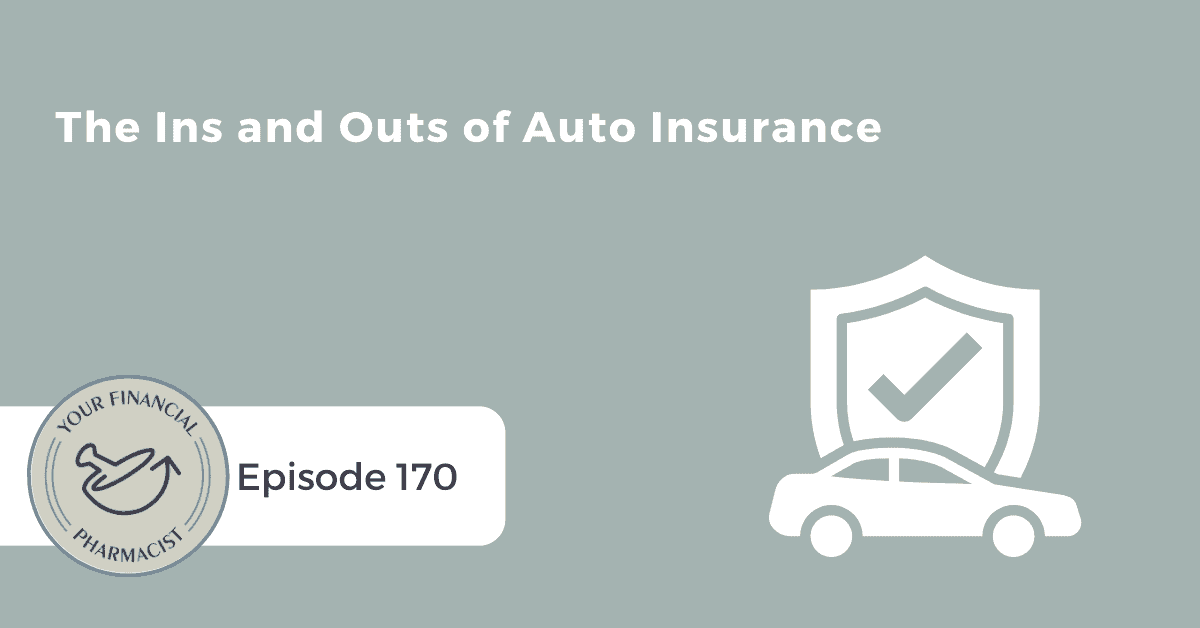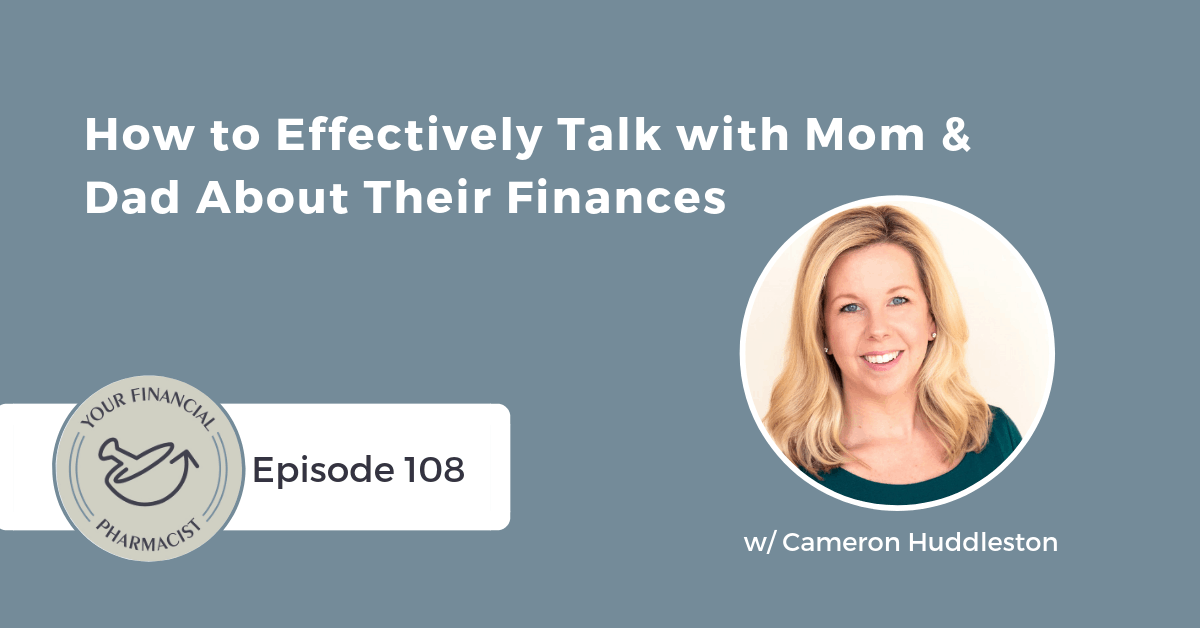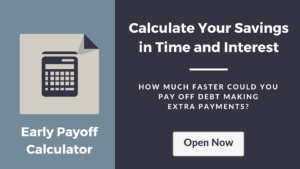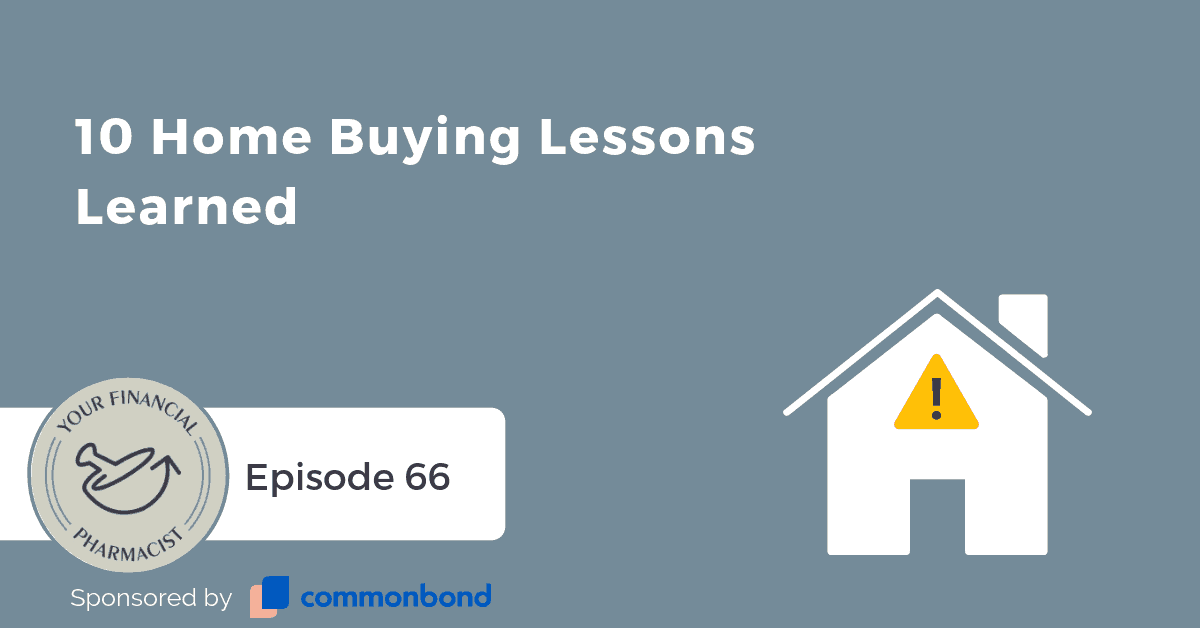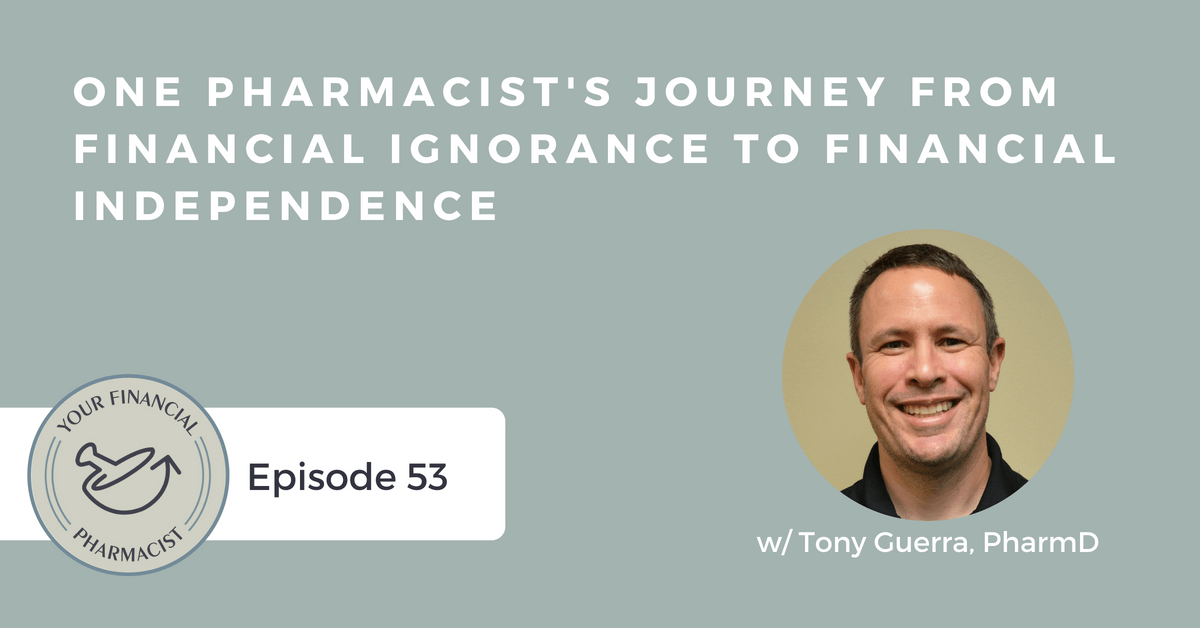The Ins and Outs of Auto Insurance
Robert Lopez, YFP’s Lead Financial Planner, joins Tim Ulbrich to talk about the ins and outs of car insurance. Robert digs into why it’s an important part of the financial plan, key terminology, how rates are calculated, the make-up of an auto insurance policy and common mistakes to avoid when purchasing car insurance.
Summary
Robert Lopez, Lead Financial Planner at YFP, shares that car insurance is an important part of someone’s financial plan for two reasons: it has to be paid monthly, semi-annually or annually and if you do get into an accident, it can be a large expense that affects the rest of your plan especially if you aren’t prepared for it.
Robert talks through the main pieces of a car insurance policy like bodily injury liability, property injury liability, medical payments or personal injury protection, collision, comprehensive, uninsured/underinsured motorist coverage and extras like roadside assistance and rental car reimbursement. He also explains that car insurance rates are determined depending on the address/city the insurer lives in as well as their driving record, credit, past claims, vehicle, daily commute or annual mileage and age.
It can be difficult to determine what you need or what coverage you should leave out when choosing a plan. Robert says that it really depends on your specific situation, what state you live in and if you have a new car. Personally, Robert likes having roadside assistance, rental reimbursement and windshield replacement coverage, but those extras may not be necessary for someone else. He also says that it depends on your financial situation and what you can pay now as well as what you can pay if or when an accident occurs.
Tim and Robert also discuss how to choose an insurance company and common mistakes that he sees others make.
Mentioned on the Show
- YFP Financial Planning
- YFP 164: The Pros and Cons of Paying Cash for a Car
- Book a Free Discovery Call with our Certified Financial Planning Team
- YFP Facebook Group
Episode Transcript
Tim Ulbrich: Robert, excited to have you back on the show. How are things going out in Phoenix?
Robert Lopez: You know, it’s hot. So there’s always that to worry about. I think it’s going to be cool today. It should only be 102, so we’re doing better.
Tim Ulbrich: Gees. We’re starting here in Ohio, we’re getting the beginnings of fall weather, doesn’t feel like a normal fall, though. We don’t have of course normal football season here in the Buckeye State, but nonetheless, we’re starting to transition to some of the most beautiful weather here. So 102, that’s pretty intense. But today we’re talking about something that I think is an often overlooked part of the financial plan, and we’re going to get your perspective as it relates to working with clients and looking at this piece of the puzzle. And as we talk about all the time, the financial plan is a giant puzzle. This is one piece, albeit an important piece of the puzzle. And I know that car insurance premiums, you know, they’re not the most expensive bill necessarily, but we’re going to talk about the importance of having the right insurance protection in place as it does with other insurance policies can affect the rest of your financial plan in big ways. So Robert, let’s start with what impact does car insurance have on the financial plan? And why is it important for people to really understand their auto insurance coverage?
Robert Lopez: Yeah, so auto insurance is really important to the financial plan for two reasons. One, you have your monthly or your semiannually premiums you’re going to be paying. And then if you are in an accident or an incident, those are large expenses that we may or may not be prepared for. I myself just had my car totaled a few weeks ago, and that was a rather large bill that I would not prefer to pay on my own. So insurance is there to protect you from some of those unforeseen expenses.
Tim Ulbrich: Yeah, and whether that be an emergency fund or if somebody doesn’t have an emergency fund, having to go into debt to cover those, obviously as we talk about with life or disability, there’s the protection part of the financial plan or most recently we talked about professional liability on the show. The other area I think about here, Robert, I’d like your input and perhaps something you see often with clients, whether it’s auto insurance, home insurance, disability or life, is that some people may be underinsured, which of course is what you just referenced, or perhaps overinsured, right, which could affect not only what’s coming out of pocket but perhaps also the opportunity cost of where that money could be used elsewhere in the financial plan.
Robert Lopez: It’s a problem both ways, but overinsured is definitely a thing. A lot of times we’ll hear clients say they just want to make sure, they want to be positive that they have enough coverage, but they’re really doing a disservice to themselves by being overinsured because as you mentioned, that opportunity cost. Those funds could go to another place, right? Maybe we want to expand our emergency fund and those extra premiums could be going towards that. Maybe we’d rather be paying down debt with that extra money. So rather than protecting ourselves from an unknown future, we could actually be paying something down today. We try to find that balance between having enough coverage and having too much coverage.
Tim Ulbrich: So let’s jump into some basic terminology before we talk about how rates are calculated, before we talk about what makes up a policy and some common mistakes that we see when folks are purchasing it. So basic definitions: premium, deductible, what’s the difference between the two as it relates to car insurance?
Robert Lopez: So your premium is that expense that you get every set time period. So it’s a monthly payment, it can be semiannual, it may be annual. But it’s the expense you pay just to maintain your coverage. The deductible is the amount that you’re required to pay after an incident or accident prior to the insurance kicking in. So think of that as your skin in the game. So they want to make sure that you’re covering part of an incident so you’re not overcharging them for the policy.
Tim Ulbrich: And as many of our listeners know, of course being in the healthcare field, this terminology they’re familiar with and not only for their own personal plans but obviously in working with their patients. But we’ll talk about that in more detail in terms of obviously how a high or a low deductible plan may impact your premiums. And as you’re shopping around, making sure you’re really trying to do as much as possible of an apples-to-apples comparison. So Robert, talk to us about how car insurance rates are calculated and what’s really taken into account in consideration when calculating those rates.
Robert Lopez: So insurance companies are really good at math. And they can find out exactly what proportion of the population is going to need to have benefits paid out. So they try to take everything into consideration they can, right? So this is going to come down to your address, meaning what area of the country you’re in and what area of a city you may be in. They’re going to look at your specific driving record, have you had incidents in the past. They may look at your credit, except where state laws maybe ban that, but viewing your credit would also kind of show a dependability. They’re going to look at past claims, like are you the squeaky wheel that keeps making claims? They’re going to look at your vehicle, and the vehicle maybe if it’s an expensive vehicle where maintenance would be higher or a faulty vehicle that may have more issues. They’re going to look at your daily commute or your annual mileage that you have, so how much are you driving to and from work because that’s the time period where you’re most likely to get into an incident or an accident. And then what’s your age? Some auto insurance agencies have a set age where they say you’re now an adult. And it may not be 18. You may hear numbers like 25, you may hear numbers like 26. But they’re going to say younger people are mathematically more likely to have accidents and claims.
Tim Ulbrich: And let’s jump into the components, the parts, of a car insurance policy as I think this is going to help our listeners not only evaluate their own policies but as they’re perhaps comparing different quotes or looking at maybe changing insurance policies, really understanding what is or is not required — and we’ll talk about obviously state laws that are impacting that — but also as you’re comparing one policy to another, understanding what is or is not included within those policies. So Robert, give us the key components of a car insurance policy and just fire them off. And then we’ll spend some time talking through those in more detail.
Robert Lopez: Yeah, so the main types of coverages you’re going to see are bodily injury liability; property damage liability; medical payments or medpay, also known as personal injury protection; collision; comprehensive; uninsured or underinsured motorist coverage; and then there’s a bunch of extras out there like roadside assistance, gap insurance, rental reimbursement, really anything that your heart desires.
Tim Ulbrich: Let’s go through those in more detail. Bodily injury liability, talk to us about that one.
Robert Lopez: So bodily injury liability is designed to pay for the medical bills and lost wages when an accident is your fault. So when you cause an accident, you run the stop sign, you run the red light, you hit the other car, this pays for their medical bills and any lost wages.
Tim Ulbrich: And one of the things — I’m deviating here a little bit, Robert — but just thinking about from planning standpoint, if I’m somebody who caused the accident, it was deemed to be my fault, what I’m thinking about is the spectrum of healthcare costs that could be incurred, right? It could be as small as an urgent care visit or a brief hospital stay or as significant as somebody who needs to be life flighted for a more serious injury. So in your experience and what you have viewed in these policies, how do you begin to evaluate obviously the range of how catastrophic it could be but also then what those policies may or may not cover and then what additional coverage you may need to be able to protect other parts of your financial plan. I’m thinking in the event of something like a lawsuit.
Robert Lopez: Yeah, that’s actually a really good question. So when you work with an insurance agent, they should be able to help you figure out some of those limits. They could be as low as what we call 25-50. Meaning it could pay up to $25,000 per person involved in an incident and $50,000 overall. Generally, we’ll recommend 100-300, meaning $100,000 per person, $300,000 per incident. It can go all the way up to 300-300 or 350-500. And that’s going to be really dependent on your area, the kind of people that you’re going to be surrounding yourselves with, and your own net worth. And that’s kind of what we’re protecting there, right? So if you find yourself driving around near a bunch of surgeons in a very high income area, then maybe your liability protection should be higher. Obviously if a surgeon has to take off a year to recover from injury, those lost wages are going to be a little above those limits. And this may be the place where a umbrella could come into effect above and beyond this liability coverage to protect from those larger lawsuits.
Tim Ulbrich: For those that aren’t as familiar with the concept of an umbrella policy, briefly define that for us.
Robert Lopez: Yeah. So an umbrella policy is just a pure liability policy, protection that goes above — like an umbrella — above any of your other liability suits. So let’s say you have an accident or an incident where someone is suing you for $500,000 of liability, your car insurance would go up to its maximum, so if it’s 100-300, it would cover that $100,000 per person. And then the umbrella policy would cover you above and beyond that. Those are generally sold in $1 million increments. They’re generally pretty fairly priced, similar to HPSOs, professional liability policies, so it should cost about $100-120 a year.
Tim Ulbrich: Awesome. OK. So bodily injury liability is the first main type of coverage. What about property damage liability?
Robert Lopez: Property damage liability pays to repair or replace property that you destroy with your car. So let’s say you get into an accident, and you hit other cars or a fence, you slide into a gate and it has to be replaced, that would cover that. So that normally is going to look like $50,000 is the kind of going rate that you’ll see for that.
Tim Ulbrich: OK, and the third one you mentioned was medical payments, referred to or abbreviated as med pay or personal injury protection.
Robert Lopez: Yeah. So personal injury protection pays for the medical expenses suffered by you and any passengers within your vehicle. So this doesn’t matter who’s at fault for the incident; your coverage will protect you and yours. If the incident is proven to be the other driver’s fault, you could go for them to seek damages, but this protection is specifically designed to protect you and yours.
Tim Ulbrich: OK. And what about collision?
Robert Lopez: Collision coverage pays to repair your own vehicle in the event of an accident. The collision claim check is generally going to be reduced by your collision deductible. So that’ll be specific to your policy. But this is just to repair your car in the event of an accident.
Tim Ulbrich: And comprehensive?
Robert Lopez: Comprehensive goes beyond accidents, right? So if your car is damaged in an accident, it’s collision coverage. If it’s damaged outside of an accident, so think if there’s a theft, fire, vandalism, storm damage, hail damage, collision with an animal, hitting a deer on the side of the road kind of thing, all that would be considered comprehensive coverage. So that would pay if your car needs repairs in that instance.
Tim Ulbrich: And uninsured or underinsured motorist coverage?
Robert Lopez: If you hit another driver or another driver hits you and they don’t have the proper insurance in place, this would protect you from that. So normally, the other insured individual would pay for the damages if the incident is their fault. If they are uninsured or underinsured, this covers you. So this is not required in most states, but it’s highly recommended since the insurance rate in America is not at the 100% that we’d like to see.
Tim Ulbrich: And my favorite category, the last one here, the catchall of extras like roadside assistance.
Robert Lopez: Yeah. So in extras, you’ll see a lot of different things. So roadside assistance is one of them. So that pays for fees due to a vehicle breakdown. So let’s say you run out of gas on the side of the road or you need a tow truck to come pick you up, this would be included in your insurance, so you would not have to pay those fees. Other options are rental reimbursement, so I mentioned my car was totaled recently. My rental reimbursement paid me to have a rental car while my car was being inspected and see if they were going to replace it or repair it. So it’s generally just up to whatever level you decide. So if you have economy, then it will pay for an economy car. If you have a specialty convertible, then it’ll pay for that. And then gap insurance is one I want to definitely make sure we touch on.
Tim Ulbrich: Yeah.
Robert Lopez: Gap insurance pays for the gap between what you owe on your car and what a car is worth. So let’s say I have a brand new car, it cost $25,000. I have a loan for $20,000 still. I get into an accident, my car is totaled. But the value of that car is only $14,000 just because of the depreciation as soon as you drive off the lot. So gap insurance would cover that difference. It was a $20,000 loan, $14,000 car, it covers the $6,000 difference there so I’m not in the hole for a car that is no longer able to be driven.
Tim Ulbrich: Yeah, really important, especially as we’ve talked about before on the show, thinking about how cars depreciate in value. Many people are likely in a scenario where they may owe more on the vehicle than the car is worth. So Robert, as I hear these things, bodily injury liability, property damage, medical payments, collision, comprehensive, uninsured or underinsured, extras, gap coverage, I understand. You did a great job of explaining them. My thought is what do I need? And what do I not need? And how do you know what coverage you need to have? Does it depend on the state? What is you’re leasing or buying? What if it’s a new car versus a beater you’re driving around? How do you think about this and advise clients as it relates to their own insurance policies?
Robert Lopez: Yeah, I’ll go back to Tim Baker’s favorite response: It depends. So it really comes down to what your specific situation says. So some states only require you to carry liability coverage, meaning you wouldn’t require any kind of collision, comprehensive, or any kind of things like that. You would only need coverage for if you were at fault. That’s not recommended for most newer cars because you’re going to want to get your car replaced and repaired. So if you have a new car with a loan, the loan company or the bank will generally require you to have full, comprehensive coverage, meaning they want to make sure the car will be replaced because they’re using that car as collateral against the loan. So they want to make sure that it maintains its value. So it’s really going to come down to your personal preference. I like having rental reimbursement and roadside assistance on my car. They’re not necessary. I like adding windshield replacement because in Arizona, we just catch rocks for fun with our windshields, so I like to have that policy built in there. Beyond that, it’s really going to come into your personal financial situation and what you can afford to pay now and what you could possibly afford in the event of an incident or accident.
Tim Ulbrich: Yeah, great point. And I think for those listening, my encouragement would be as you understand the individual components of the policy and then evaluate your own plan, your own vehicle situation. So as you mentioned, somebody’s driving around in a new car, somebody’s driving around a vehicle with 150,000 miles on it that’s worth $4,000 or $5,000, they may approach this very differently in terms of what they’re looking for things to get replaced or covered in the event of an accident and how their personal financial situation may be able to cover some of those costs that come or perhaps it may not. And they may need that coverage, but really understanding the individual components, understanding your situation, and then as you begin to shop around, once you determine the need, really being able to look at Policy A versus Policy B versus Policy C based on those individual coverage maximum limits and what you need or don’t need for your own situation. Now that we know what makes up a car insurance policy and the basics of what that policy covers, let’s talk a little bit about car insurance companies, really between brick-and-mortar and online companies, I guess not much brick-and-mortar these days. You know, people walking into talk with an agent. We’ve got big insurers, we’ve got small insurers. I feel like there’s so many options, and I’m even thinking about watching an NBA game recently where I felt like every third or fourth commercial was a company who’s shopping around. There’s lots of them out there, and I think it can be confusing about where do I go? What should I be looking for? How should I be evaluating it? So how do you begin to decide which car insurance company is going to suit your needs best? And what are the main things that our listeners should be thinking through when choosing a car insurance company?
Robert Lopez: Yeah, I think a lot of it’s going to come down to kind of four main areas. First of all, location. Not all of these companies are going to be operating in every area. There are other things to worry about, there are price. Right? So price is going to be huge because there’s going to be drastic differences in cost. So we want to make sure that we compare and shop around on prices to all of the agencies. Another one would be trust or reliability. There’s online organizations, Bank Rate does it, there’s a ton of organizations that will rank insurance companies based on financial strength, basically their stability, and then by claim satisfaction score. You can look online and say, hey, this company is extremely financially stable, it’s not going to disappear overnight like one of these odd commercials that we see on TV, and I know that their claim satisfaction score is high. So people who are actually filing claims are happy with the service they receive. And then the last thing is going to be comfort level. Are you already familiar with a company and do you like them? Are you already familiar with the bank that provides that service as well? Is there already policies that you’ve had in the past you’ve had success with their claims departments? Sometimes it’s worth a little extra to work with somebody that you’re comfortable with, whether it’s the bank or the agent themself.
Tim Ulbrich: So Robert, to that point, and one of the things I often struggle with is — I’m even thinking about right now my own auto and home policies and recently shopped those around to get new updated rates and bundled options and all that good stuff. You can shop around ‘til you’re blue in the face and find a better price, and you mentioned some things that are really important to consider, not just price alone. But the one that stands out to me is that customer service, comfortability with the individual carrier as well as perhaps an individual relationship or contact you have. So I know for my personal auto insurance, I have somebody that for 5+ years now, quick email, quick response, I have that personal connection, and that is worth something as I look at sure, I could get a cheaper option, but how much cheaper does that need to be to be able to outweigh that? So how do you evaluate this personally, whether it be on the auto side or another type of insurance, really the importance of that relationship, the importance of the customer service relative to the price of the policy?
Robert Lopez: Personally, I like simplicity. I like to get all my policies in one place if possible so I just have one contact. And I like to deal with one organization. I’m lucky enough to be a prior military member, so I can use USAA as my bank, I can use my USAA as my insurance policy company, I can USAA as a lot of things. So that’s what I personally like. I know that I’m probably paying a premium, and I do check that every year, meaning I know the comparison rates of what I would be paying elsewhere so if at one point, it turns out to not be the right mathematical choice anymore, I can make that switch. But I know that I’m paying extra just to keep that simplicity, the consistency.
Tim Ulbrich: Yeah, and this would be something that I would recommend folks, you know, put this probably among some other things that once a year is on the calendar just to look at again. We all know how fast a year can go, you’ve got competing responsibilities and priorities, and I have found even with my own carrier, asking the question sometimes, ‘Oh, I’m glad you asked, we’ve got these different options.’ Or, ‘Hey, I’m looking at these other options,’ and all of a sudden there’s new quotes that are presented. So I think once a year is good due diligence probably among other areas of the plan as you’re looking at credit reports or other things as well to make sure you’re taking care of those maintenance items as it relates to the financial plan. Like any aspect of the financial plan, Robert, it’s easy to make mistakes along the way. What are some of the common mistakes that you see people making when it comes to car insurance? And I’ll probably add on a couple that I’ve made myself as well.
Robert Lopez: Yeah, you’ll definitely hear me repeating myself from some of the stuff I already said. But some of the big ones, again, not shopping around. Just sticking with that one organization is not enough. And when we do shop around, we want to make sure we get that full picture of the marketplace. There’s a bunch of insurance companies, they change their names from time to time, but they’re still there. So you want to definitely check annually and make sure we’re comparing apples to apples. You can actually give your policy information to another agent and let them compare it and say, “I want this exact same policy from your company. What would it cost?” And they should be able to do that pretty easily. The next one is carrying too much or too little insurance. Carrying too much coverage, as we talked about earlier, being overinsured, it’s just going to increase your premiums and cost you more long term. And then not having enough coverage will lead to those larger expenses in the event of an incident. So we want to try to find that right balance between how much premium we want to pay, how much deductible we want to pay, and how much actual coverage we want to have. Some other ones, kind of buying roadside service can sometimes be a mistake. So I mentioned that I like to have that on my policy, but that’s because I don’t receive that service from any other organizations. Sometimes you can get it through a credit card company, if you have anything like AAA or if you have a vehicle warranty, a lot of times those are built in. So we want to just confirm one way or the other if we already have this service or not and then if we want to include it in our insurance policy or not. The next common mistake I see is people not updating their service, their policies, so carrying collision coverage on an older car is not necessarily the right thing. So remember, collision coverage protects your car in the case of an incident. If you have an older car that’s not very valuable, then that coverage is not going to pay out as much as it used to. So you’re likely overpaying for that part of the policy. In that same breath, just generally not updating your policy to reflect your life changes is a big one. So keeping insurance up-to-date on your situation is really going to ensure that you’re receiving the correct rates. We have a lot of people who are working from home right now, so they’re driving less. So their policy should be lower cost to reflect that because they’re less likely to get into an incident if they’re not driving to work every day. Not getting that premium versus deductible balance right, so increasing your deductible is a great way to lower your premiums, but you need to make sure that you’re able to actually afford that deductible when the time comes. Just trying to get your premium as low as possible and having a $4,000 or $5,000 deductible in the future sounds great until the future gets here, and now you’re going into credit card debt to pay that deductible. And then the last one that I see is kind of getting those gimmicks in car plans. So insurance companies are all over the place, and they’re all trying to stand out. So they’ll offer different incentives or options, think accident forgiveness, and really what this does is it sounds great until you review the numbers. So we just want to make sure that we understand exactly how these programs work and we’re happy with whatever added expense they bring to us for the benefit that they state.
Tim Ulbrich: Great stuff, Robert. And I’m going to just emphasize or re-emphasize a few of those that I’ve lived firsthand. So you mentioned the buying roadside coverage, and I know again, something you mentioned you like, and I think your follow-up there was spot-on, really making sure you’re not paying for it anywhere else. So probably the most common thing that I see and I experienced myself was people not realizing that they already have AAA or another policy coverage in place and then they’re also paying for it on the auto insurance, so making sure you’re not double paying. You know, the apples to apples is so important. And I love your recommendation of actually sending your policy, sending what you are currently have in terms of coverage and limits and then asking to get a quote that will match that or if you’re looking for more or less in a certain area so you can really compare one to another in terms of an apples to apples. And then I think overpaying, you know, is something that I fall victim to myself. You know, I’ve talked about on the show before, most recently when Tim Church and I talked about the pros and cons of paying cash for a car, but we don’t drive the nicest cars in the Ulbrich household, let’s just leave it at that. There’s certain coverages that we don’t need, and if there’s an emergency fund and other areas that can cover it, then we’re trying to find that balance that you reference in terms of the premium versus the deductible. So Robert, appreciate your time coming on, and as I started the show, I’ll end the show by saying our goal as we continue to talk about different parts the financial plan is to re-emphasize that the financial plan is complicated. There’s many pieces, there’s many parts, and here we’re talking about just a sliver but an important part. And if you don’t have the right coverage, you’re exposing the rest of your financial plan. If you’ve got too much coverage, perhaps there’s an opportunity cost where you could be better allocating those monies to a different part of the financial plan. So we do comprehensive financial planning at Your Financial Pharmacist, specifically customized for pharmacy professionals. And we define comprehensive financial planning as anything that has a dollar sign on it, we want to be involved in that part of the financial plan. So that ranges from debt management, that includes investing and retirement, that includes insurance here, just one part of insurance we’re talking about today, credit, credit management, home buying, the list goes on and on as we know that all parts of the financial plan impact one another. And so if you’re interested in learning more about our comprehensive, fee-only financial planning services, head on over to YFPPlanning.com, where you can schedule a free discovery call to see if that service is a good fit for you. And as always, if you liked what you heard on this week’s episode of the Your Financial Pharmacist podcast, please leave us a rating and review on Apple podcasts or wherever you listen to the show each and every week. And I hope you’ll join us in the Your Financial Pharmacist Facebook group, where we now have more than 6,000 pharmacy professionals active and committed to helping one another on their path towards achieving financial freedom. Have a great rest of your week.
Current Student Loan Refinance Offers
[wptb id="15454" not found ]Recent Posts
[pt_view id=”f651872qnv”]

